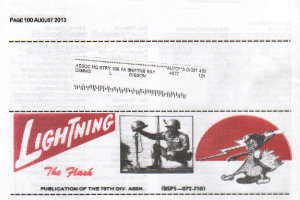 A ten-year-old blog post recently appeared in this site’s traffic statistics. The post told about the last issue of a publication devoted to a veteran’s organization to which my father had belonged. It isn’t terribly unusual for ten-year-old posts to get hits but I really can’t remember the last time this particular post appeared. The hit prompted me to reread the post and even update it a little. In the process, I was also prompted to let my thoughts wander down several of the many paths uncovered by my reading. Whoever clicked on the search result that took them to this old post missed Veterans/Armistice Day by a couple of weeks and this post misses it by even more but my mind — and maybe yours too — is still in a slightly reflective mood. So this week’s post consists of just this paragraph and a link to that ten-year-old post. Reflect as much or as little as pleases you: One Last Flash
A ten-year-old blog post recently appeared in this site’s traffic statistics. The post told about the last issue of a publication devoted to a veteran’s organization to which my father had belonged. It isn’t terribly unusual for ten-year-old posts to get hits but I really can’t remember the last time this particular post appeared. The hit prompted me to reread the post and even update it a little. In the process, I was also prompted to let my thoughts wander down several of the many paths uncovered by my reading. Whoever clicked on the search result that took them to this old post missed Veterans/Armistice Day by a couple of weeks and this post misses it by even more but my mind — and maybe yours too — is still in a slightly reflective mood. So this week’s post consists of just this paragraph and a link to that ten-year-old post. Reflect as much or as little as pleases you: One Last Flash
Tag Archives: Family
Dynamic Traditions
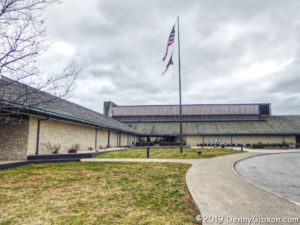 The ways I have experienced Thanksgiving are many. Early in my life it was as the large family gathering typically presented as the ideal. I don’t disagree. There were seldom seen relatives bringing an astonishing assortment of edibles; Some you’d been craving for a year while others you just hoped your parents wouldn’t make you eat. But we could never put together that Norman Rockwell scene with everyone sitting around a single table. Instead, Grandma’s house was filled with happy people eating in the kitchen, at folding tables, and from full plates balanced on knees. Marriage triggered a switch from celebrating the day with the large family in Darke County to the small but growing family in Cincinnati. Divorce changed things, too.
The ways I have experienced Thanksgiving are many. Early in my life it was as the large family gathering typically presented as the ideal. I don’t disagree. There were seldom seen relatives bringing an astonishing assortment of edibles; Some you’d been craving for a year while others you just hoped your parents wouldn’t make you eat. But we could never put together that Norman Rockwell scene with everyone sitting around a single table. Instead, Grandma’s house was filled with happy people eating in the kitchen, at folding tables, and from full plates balanced on knees. Marriage triggered a switch from celebrating the day with the large family in Darke County to the small but growing family in Cincinnati. Divorce changed things, too.
As a single, I shared Thanksgiving with friends and friends’ families. Some gatherings had a real “Alice’s Restaurant” feel though without the court appearance. That phase ended when three kids moved in. The “head of household” period saw some awkward attempts at feast making by me and some much more successful efforts by girlfriends. A shortlived second marriage included a new family to celebrate with. My current solo period began when the last of the young ‘uns moved out.
It was a little different than it had been before the family period. I was invited to join friends for holidays but everybody was a little more mature now. There was no question of me being genuinely welcome but I saw myself as more of an add-on than I once had. I dealt with the situation by running away. I first ran away for Thanksgiving in 2005. I started running away for Christmas in 2006.
I have left home for every Christmas since then. My Thanksgiving escapes have been less consistent. Since 2009, Thanksgiving has been a mix of home and away for me. Somewhere along the way, I realized that many state parks offer buffets on holidays. It’s something I’ve taken advantage of for both Thanksgiving and Christmas. Last year, my daughter and I enjoyed a traditional Thanksgiving meal at a local restaurant. This year we borrowed from my “away” experience and took in the buffet at Deer Creek State Park.
 The place was absolutely packed and they were running behind schedule. That wasn’t much of an issue for us as there was a bar area in the lodge where we could pass the time with beer in hand. Our name was called about forty-five minutes after our scheduled time and we were seated at what we considered a primo spot overlooking the lake.
The place was absolutely packed and they were running behind schedule. That wasn’t much of an issue for us as there was a bar area in the lodge where we could pass the time with beer in hand. Our name was called about forty-five minutes after our scheduled time and we were seated at what we considered a primo spot overlooking the lake.
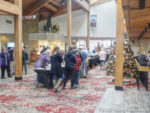 We joked about the possibility of there being nothing left to eat for us but that wasn’t the case at all. The only thing that ever seemed to get depleted was the stack of plates but even that shortage didn’t last long as the staff hustled to get clean ones to the table as soon as they were ready. The food was quite good and included all the standards like turkey, ham, stuffing, and potatoes along with some nice cold shrimp and baked salmon.
We joked about the possibility of there being nothing left to eat for us but that wasn’t the case at all. The only thing that ever seemed to get depleted was the stack of plates but even that shortage didn’t last long as the staff hustled to get clean ones to the table as soon as they were ready. The food was quite good and included all the standards like turkey, ham, stuffing, and potatoes along with some nice cold shrimp and baked salmon.
I realize that none of the pictures here are very good. They were taken with little care with my pocket camera. But more important than the quality is the absence of any pictures of my daughter or me with full plates. Heck, there aren’t even any pictures of the full plates and that’s just about unheard of in a Thanksgiving Day post. The truth is I had no intention of posting anything about the day and only snapped the few pictures I have because that’s what I do. In hindsight, I do wish I’d asked our waitress to snap a picture of us at our table but accept the fact that I’m lucky to even have a picture of the table.
I was also lucky in spending time with my daughter. I didn’t actually speak with either of them, but I did exchange text greetings with my sons in New York and California. There’s a meme bouncing around the interwebs with the observation that “Happiness is when you realize your children have turned out to be good people.” I realized that a long time ago but the fourth Thursday of November is a very good time to remember it and to be thankful for it.
Memories of the Eagle
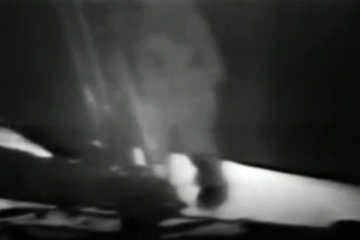 My best guess of what I was doing exactly fifty years before the publication of this post is sleeping. I wouldn’t be sleeping much longer because it was Monday morning and I would have to wake up and go to work. And I would not have been asleep very long either. I would have stayed up way too long watching TV after a long drive home. Just having the possibility of watching TV late at night was unusual even at the very end of the 1960s. With the exception of Bob Shreve’s all-night movies on Saturday, all five Cincinnati channels went off the air around midnight. But the wee hours of July 21, 1969, were different. It was the day following the day when the Eagle had landed. There was news to be shared.
My best guess of what I was doing exactly fifty years before the publication of this post is sleeping. I wouldn’t be sleeping much longer because it was Monday morning and I would have to wake up and go to work. And I would not have been asleep very long either. I would have stayed up way too long watching TV after a long drive home. Just having the possibility of watching TV late at night was unusual even at the very end of the 1960s. With the exception of Bob Shreve’s all-night movies on Saturday, all five Cincinnati channels went off the air around midnight. But the wee hours of July 21, 1969, were different. It was the day following the day when the Eagle had landed. There was news to be shared.
We — my wife, our son, and I — were visiting friends in Saint Louis over that weekend. Our plans were to be home at a decent hour but we were paying more attention to someone else’s travel plans than our own. While we were on our way to Saint Louis, Michael Collins, Buzz Aldrin, and Neil Armstrong were on their way to the moon. As we prepared to drive home, Buzz and Neil prepared to head for the Lunar surface. At 13:44 EDT on that Sunday afternoon, the pair separated from Michael and the command module Columbia and began their descent. At 16:17 EDT, Armstrong announced that “The Eagle has landed.”
The timestamps on my own recollections aren’t nearly as precise or reliable as NASA’s. Part of me thinks that we did not leave Saint Louis until after the Lunar Module was on the surface. Information currently available online says that a four hour rest period was planned between landing and exiting. If that was the information we had then and if we really did not depart until the Eagle landed, then I must have thought I could drive to Cincinnati in under four hours or maybe I was terribly confused by time zones. Or maybe we were counting on the astronauts sleeping for the full four hours then spending considerable time preparing to leave the lander. Whatever the reasons and reasoning, I know for certain that as we headed toward home, we believed we had a good shot at making it in time to watch man’s first step onto the moon.
There was no radio in the car. Not even AM. The vehicle’s entertainment system consisted entirely of an under-dash 8-track tape deck. That was normally not a problem since no one in their right mind would want to listen to news or the top 40 when all seven minutes of Light My Fire was available in stereo with the click of a cartridge. But this drive was not normal and we really did want to listen to news. As I recall, the Bairds, who we were visiting in Saint Louis, loaned us a portable transistor radio which we propped atop the dash and fiddled with almost constantly as signal strength ebbed and flowed.
The details were forgotten long ago, but I remember that somewhere along the way we heard that the rest period was going to be shortened and the astronauts would be stepping from the capsule earlier than once thought. Whether or not we ever actually had a legitimate chance of reaching home before that happened seems doubtful to me now. But, regardless of how likely or unlikely that had been, it now became clear that it was pretty much impossible. If we continued our drive, human beings were going to be walking on the moon while our only connection was a tiny radio with temperamental reception.
We were still somewhere west of Indianapolis when that realization struck. Like so many other details of that day, I cannot recall our thought processes as we left the expressway in search of a television. We did this near the airport and I know that at least part of the reason was that we knew there were motels in the area. There surely was no money for rented lodging in our family budget so it seems unlikely that we planned on spending the night. On the other hand, this was a truly major event so it’s possible that we were at least considering it. Checking prices may have even been on my mind when I stepped into the hotel lobby. If so, I’m sure it vanished when I saw the TV playing in the furnished lobby. I left and quickly returned with the family.
I think of it as a Holiday Inn but, in reality, it could have been any of the slightly upscale (to a 22-year-old father) motels of the time. Whatever the brand, it was upscale enough that flight crews from multiple airlines regularly overnighted there. My wife and I found seats on a sofa with 5-month-old Crispian parked in front of the TV in a little plastic carrier commonly referred to as a “pumpkin seat”. The three of us became lobby fixtures while others watched the TV for a bit on the way to their rooms.
Time moved slowly as we waited for the astronauts to step outside the capsule. Multiple flight crews arrived while we waited and each followed the same procedure. One member went to the desk to check in the entire crew while the others stood behind the sofa staring over our heads at the glowing screen. When the paperwork was completed, the unlucky person who had somehow been chosen to perform it, distributed keys and everyone rushed off to their individual accommodations and personal televisions.
 At 22:56 EDT, Neil Armstrong stepped onto the Lunar surface. The picture at the top of this article shows his foot hanging from the Lunar Module’s ladder just before that happened. After Buzz joined him, Neil placed the camera on a tripod to provide a more panoramic view. The black and white images were dim and blurry and sometimes flickered away. And they were beautiful.
At 22:56 EDT, Neil Armstrong stepped onto the Lunar surface. The picture at the top of this article shows his foot hanging from the Lunar Module’s ladder just before that happened. After Buzz joined him, Neil placed the camera on a tripod to provide a more panoramic view. The black and white images were dim and blurry and sometimes flickered away. And they were beautiful.
I halfway think we stayed in that hotel lobby during all of the approximately two and a half hours of Extravehicular Activity but I’m not at all certain. I am certain that Cris saw that first step because I checked to make sure his eyes were open. Of course, any memories he has of the event are almost certainly from repeatedly being told about it rather than from what he actually saw. My great grandfather had been dead just over eight years at the time of the moon landing but he had lived to see three humans (Gargarin, Shepard, Grissom) in space. He was born in 1875 and was almost exactly the same age as the kid in the pumpkin seat when Custer’s troops were annihilated at Little Big Horn. As my son watched dim images of men nearly 240,000 miles away and I watched him, I wondered what advances he would see in his lifetime. Fifty years in, the list is impressive and growing.
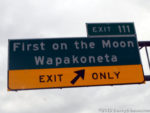 A ten-day 50th anniversary celebration in Wapakoneta, Ohio, Neil Armstrong’s hometown, wraps up today. The final event is a 7:00 Wink at the Moon concert featuring the Lima Area Concert Band. Other concerts and events have filled the ten days in downtown Wapakoneta and at the Armstrong Air & Space Museum at the edge of town. I visited Tuesday, the anniversary of the rocket launch that started Neil and his buddies on their way to the moon.
A ten-day 50th anniversary celebration in Wapakoneta, Ohio, Neil Armstrong’s hometown, wraps up today. The final event is a 7:00 Wink at the Moon concert featuring the Lima Area Concert Band. Other concerts and events have filled the ten days in downtown Wapakoneta and at the Armstrong Air & Space Museum at the edge of town. I visited Tuesday, the anniversary of the rocket launch that started Neil and his buddies on their way to the moon.
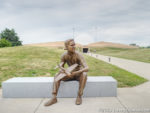
 Two new statues of Armstrong had been unveiled at the museum on Sunday. It’s a bit disappointing that the white clouds and low light make the moon-like dome of the museum so hard to see. I photographed the statues before the crowd started to arrive but noted later that the statue of the young dreamer was — and I’m sure will be — a very popular place for families to pose their younger members for photos. A third statue, of Armstrong in his 1969 welcome home parade, was to be unveiled downtown on Thursday.
Two new statues of Armstrong had been unveiled at the museum on Sunday. It’s a bit disappointing that the white clouds and low light make the moon-like dome of the museum so hard to see. I photographed the statues before the crowd started to arrive but noted later that the statue of the young dreamer was — and I’m sure will be — a very popular place for families to pose their younger members for photos. A third statue, of Armstrong in his 1969 welcome home parade, was to be unveiled downtown on Thursday.
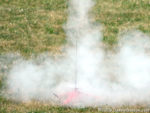
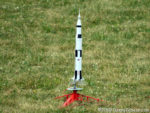 As 9:32 approached, attention was focused on a 22-inch replica of the Saturn 5 rocket that had lifted off in Florida at that time exactly fifty tears earlier. A recording of that half-century-old countdown was played to help coordinate the launch of the model. The model was a solid fuel-powered Estes much like the ones I helped build and launch even more than fifty years ago. When the count reached zero, I was quickly reminded that the acceleration characteristics of an Estes rocket are much closer to those of a bullet than to those of a 6.5 million pound 363 foot Saturn 5.
As 9:32 approached, attention was focused on a 22-inch replica of the Saturn 5 rocket that had lifted off in Florida at that time exactly fifty tears earlier. A recording of that half-century-old countdown was played to help coordinate the launch of the model. The model was a solid fuel-powered Estes much like the ones I helped build and launch even more than fifty years ago. When the count reached zero, I was quickly reminded that the acceleration characteristics of an Estes rocket are much closer to those of a bullet than to those of a 6.5 million pound 363 foot Saturn 5.
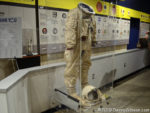
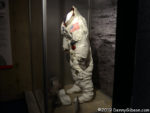 Following the countdown and launch, the museum was opened — and filled. I waited outside for the initial rush to pass although the place was still pretty busy when I did go in. The first picture is a reminder that Armstrong’s career did not begin with the moon landing. It’s the suit he wore on Gemini 8. His partner on that flight was David Scott who made it to the moon himself on Apollo 15. The second picture is of Armstrong’s backup suit for Apollo 11. On the day I took this photo, July 16, the Smithsonian returned the suit worn on Apollo 11 to display after being out of sight for some time being repaired.
Following the countdown and launch, the museum was opened — and filled. I waited outside for the initial rush to pass although the place was still pretty busy when I did go in. The first picture is a reminder that Armstrong’s career did not begin with the moon landing. It’s the suit he wore on Gemini 8. His partner on that flight was David Scott who made it to the moon himself on Apollo 15. The second picture is of Armstrong’s backup suit for Apollo 11. On the day I took this photo, July 16, the Smithsonian returned the suit worn on Apollo 11 to display after being out of sight for some time being repaired.
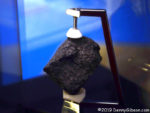 Just beyond where this piece of the moon is displayed, is a movie that runs every half hour. Many other artifacts and information panels are in that room where I spent fifteen minutes or so waiting for the next showing. It was there that I was struck by the fact that I was one of the few people in that museum who actually remembered the Apollo expeditions. Many were adolescents born decades after the moon landings, but it was clear from overheard comments and answers to youthful questions that most of the parents and even grandparents weren’t around in 1969 or were too young to have solid memories. I’ve since learned that only four of the twelve men who walked on the moon between 1969 and 1972 are currently living. Yeah, I guess that really was a ways back.
Just beyond where this piece of the moon is displayed, is a movie that runs every half hour. Many other artifacts and information panels are in that room where I spent fifteen minutes or so waiting for the next showing. It was there that I was struck by the fact that I was one of the few people in that museum who actually remembered the Apollo expeditions. Many were adolescents born decades after the moon landings, but it was clear from overheard comments and answers to youthful questions that most of the parents and even grandparents weren’t around in 1969 or were too young to have solid memories. I’ve since learned that only four of the twelve men who walked on the moon between 1969 and 1972 are currently living. Yeah, I guess that really was a ways back.
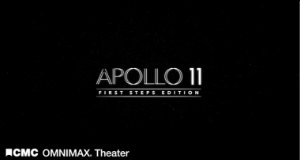 On the anniversary of the actual landing, I watched a movie. Apollo 11: First Steps Edition is a version of Apollo 11 created for OMNIMAX style theaters. Yesterday’s showings are the only ones planned for the theater at the Cincinnati Museum Center but I believe this is the same movie being shown elsewhere including the Air Force Museum in Dayton. Made entirely of archival footage, it gave everyone in the sold-out theater a glimpse inside the historic mission and refreshed memories for a few of us. Sometimes the images are so big or there are so many of them that it’s hard to take it all in. It was that way the first time, too.
On the anniversary of the actual landing, I watched a movie. Apollo 11: First Steps Edition is a version of Apollo 11 created for OMNIMAX style theaters. Yesterday’s showings are the only ones planned for the theater at the Cincinnati Museum Center but I believe this is the same movie being shown elsewhere including the Air Force Museum in Dayton. Made entirely of archival footage, it gave everyone in the sold-out theater a glimpse inside the historic mission and refreshed memories for a few of us. Sometimes the images are so big or there are so many of them that it’s hard to take it all in. It was that way the first time, too.
That concert that will be happening in Wapakoneta tonight gets its name from a statement that Neil Armstrong’s family issued at his death in 2012. “… the next time you walk outside on a clear night and see the moon smiling down at you, think of Neil Armstrong and give him a wink.” I did that last night shortly after the moon cleared the horizon. It was about the time when, fifty years earlier, Neil and Buzz’s time outside the capsule was a little more than half over. I thought of Neil and winked then winked two more times and thought of Buzz and Michael. Nicely done, fellows. Nicely done.
LHA Conference 2019
 This is a big reason why drives involved in the preceding trip were not very leisurely. In the early phases of planning, it seemed like a conference in early June and another in late June would leave plenty of room in between. The devil appeared and the leisure time vanished in the details. The early June conference filled the 5th through 8th. This, the late June conference, filled the 18th through 21st. That left what initially seemed like an ample nine days between the end of one and the start of the other. A two-day drive home from Wisconsin and a five-day drive to Wyoming trimmed all the ampleness from the schedule in a flash. I had time to do laundry and repack and am now on the way to Rock Springs, Wyoming, for the June 18-21 Lincoln Highway Association conference. The first day of the trip is in the books and on the web.
This is a big reason why drives involved in the preceding trip were not very leisurely. In the early phases of planning, it seemed like a conference in early June and another in late June would leave plenty of room in between. The devil appeared and the leisure time vanished in the details. The early June conference filled the 5th through 8th. This, the late June conference, filled the 18th through 21st. That left what initially seemed like an ample nine days between the end of one and the start of the other. A two-day drive home from Wisconsin and a five-day drive to Wyoming trimmed all the ampleness from the schedule in a flash. I had time to do laundry and repack and am now on the way to Rock Springs, Wyoming, for the June 18-21 Lincoln Highway Association conference. The first day of the trip is in the books and on the web.
This entry is to let blog only subscribers know about the trip and to provide a place for comments. The journal is here.
Burning Man at CAM
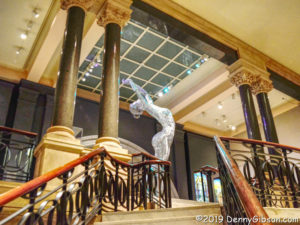 I have never been to Burning Man but I’ve a son who has. I texted him while attending the recently opened “No Spectators: The Art of Burning Man” at the Cincinnati Art Museum. “Those things aren’t supposed to make it off the playa”, he said. “Burn it. It’s in the frickin’ name.” Those aren’t angry words. They’re amused words. In context, he seemed to be chuckling at the idea of people trying to understand the annual gathering by looking at some things that had once been there. I’d already picked up some sense of how silly this was from the exhibition’s title. “No Spectators” comes from Burning Man’s “radically participatory ethic”. “Participation” is one of the community’s ten principles. No one attends the actual event as a spectator. The joke (possibly even intentional) is that, regardless of the name, the majority of people viewing the objets d’art at the museum are 100% spectators. Silly or not, I spectated profusely.
I have never been to Burning Man but I’ve a son who has. I texted him while attending the recently opened “No Spectators: The Art of Burning Man” at the Cincinnati Art Museum. “Those things aren’t supposed to make it off the playa”, he said. “Burn it. It’s in the frickin’ name.” Those aren’t angry words. They’re amused words. In context, he seemed to be chuckling at the idea of people trying to understand the annual gathering by looking at some things that had once been there. I’d already picked up some sense of how silly this was from the exhibition’s title. “No Spectators” comes from Burning Man’s “radically participatory ethic”. “Participation” is one of the community’s ten principles. No one attends the actual event as a spectator. The joke (possibly even intentional) is that, regardless of the name, the majority of people viewing the objets d’art at the museum are 100% spectators. Silly or not, I spectated profusely.
As is apparent from the first photo, the Burning Man pieces are not shuttered off in an isolated gallery but share space with the museum’s permanent displays. The Truth is Beauty standing at the top of the main staircase is a third the size of the original 55-foot tall sculpture that appeared at Burning an in 2013. A description is here; Another view here.
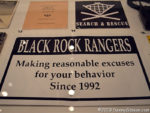
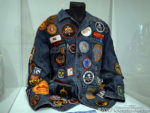 Although several examples of the art of Burning Man are unavoidably encountered on the way, there is a gallery devoted to Burning Man history which is a good place to visit before actively seeking out the rest. Burning Man of today bears little resemblance to the original 1986 event. Today it is well organized and scheduled far in advance. The “city” that is created annually in the Nevada desert now has a population near 70,000. Given the name Black Rock City, a Department of Public Works exists to operate the city and a group called the Black Rock Rangers patrols it. A large part of the Ranger’s success is credited to the fact that they are not outsiders but participant volunteers helping keep other participants safe and enjoying themselves. There is a brief description of the DPW and BRR here. The jacket belongs to DPW founder Will Roger Peterson.
Although several examples of the art of Burning Man are unavoidably encountered on the way, there is a gallery devoted to Burning Man history which is a good place to visit before actively seeking out the rest. Burning Man of today bears little resemblance to the original 1986 event. Today it is well organized and scheduled far in advance. The “city” that is created annually in the Nevada desert now has a population near 70,000. Given the name Black Rock City, a Department of Public Works exists to operate the city and a group called the Black Rock Rangers patrols it. A large part of the Ranger’s success is credited to the fact that they are not outsiders but participant volunteers helping keep other participants safe and enjoying themselves. There is a brief description of the DPW and BRR here. The jacket belongs to DPW founder Will Roger Peterson.
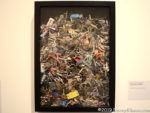
 The history display includes some actual artifacts from past events. Starting in 1998, Crimson Rose, one of the organizers, has collected remnants of the Man on the morning after the burning. The keys were found on the playa by organizers Michael and Dusty Mikel between 2005 and 2012.
The history display includes some actual artifacts from past events. Starting in 1998, Crimson Rose, one of the organizers, has collected remnants of the Man on the morning after the burning. The keys were found on the playa by organizers Michael and Dusty Mikel between 2005 and 2012.

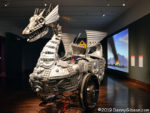
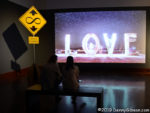 The guy on the right of the first picture is Thorax, Ambassador of the Insects. The mutant vehicle in the center picture is from 2008. It is named Tin Pan Dragon. I liked it so much that I grabbed a full side view and a shot of the video playing nearby. The big screen visible beyond the dragon show a loop of various Burning Man scenes with seating for a small audience.
The guy on the right of the first picture is Thorax, Ambassador of the Insects. The mutant vehicle in the center picture is from 2008. It is named Tin Pan Dragon. I liked it so much that I grabbed a full side view and a shot of the video playing nearby. The big screen visible beyond the dragon show a loop of various Burning Man scenes with seating for a small audience.
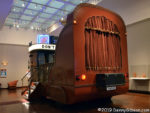
 The capacity of this theater is much higher with three rows of four seats each. Although No Spectators officially opened on April 26, several items, including this self-propelled theater were in place when I visited another exhibit just about a month ago. On that occasion, I took this picture of the screen with my phone. This time I took no screenshots but did sit through the entire presentation of silent shorts.
The capacity of this theater is much higher with three rows of four seats each. Although No Spectators officially opened on April 26, several items, including this self-propelled theater were in place when I visited another exhibit just about a month ago. On that occasion, I took this picture of the screen with my phone. This time I took no screenshots but did sit through the entire presentation of silent shorts.
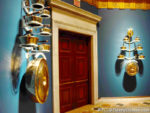
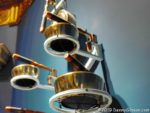 While some of the Burning Man pieces appear a little bit awkward in makeshift settings, this piece and this circular room seem made for each other. Gamelatron Bidadari is comprised of 32 bronze gongs played by computer-controlled mallets. There’s a better explanation here. The few minutes I spent in this room were the most pleasant of my entire day.
While some of the Burning Man pieces appear a little bit awkward in makeshift settings, this piece and this circular room seem made for each other. Gamelatron Bidadari is comprised of 32 bronze gongs played by computer-controlled mallets. There’s a better explanation here. The few minutes I spent in this room were the most pleasant of my entire day.
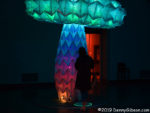
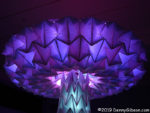
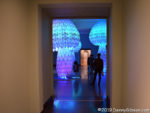 Photos of Shrumen Lumen appear in promotional materials for this exhibit including the program cover. It is one of the few items that require a little participation and at least slightly supports the “no spectators” idea. As explained here, each ‘shroom is activated by stepping on a pad at its base. In the third picture, a non-spectator steps on a pad then steps back and back again to watch the show.
Photos of Shrumen Lumen appear in promotional materials for this exhibit including the program cover. It is one of the few items that require a little participation and at least slightly supports the “no spectators” idea. As explained here, each ‘shroom is activated by stepping on a pad at its base. In the third picture, a non-spectator steps on a pad then steps back and back again to watch the show.
Phase 1 of “No Spectators: The Art of Burning Man” opened on April 26. Phase 2 additions will be made on June 7 and everything will remain through September 2. I’ll be back for Phase 2 and to listen to those gongs some more.
ADDENDUM 4-Aug-2019: As promised, I returned to the museum for Phase 2 and reported on the visit here.
Trip Peek #81
Trip #119
Route 66 Festival 2014
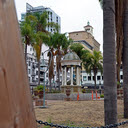 This picture is from my 2014 Route 66 Festival trip. The trip title is accurate, the Route 66 festival in Kingman, AZ, was the target, but it hides the fact that a major component of the trip was a full length drive of the Old Spanish Trail. Not only did I clinch that historic auto trail, I did it in a Mazda Miata which qualifies as the smallest car I’ve ever driven coast-to-coast. The photo is of the trip’s only disappointment. When I reached San Diego with plans to photograph the OST terminus marker, I was shocked to find the park containing it closed and being refurbished. The photo was taken through the surrounding barricades. The disappointment was soon forgotten in a visit with my younger son who lives in a suburb of San Diego. I had visited his older brother in New Orleans on the way out making this one of those rare trips where I am able to see both of my boys.
This picture is from my 2014 Route 66 Festival trip. The trip title is accurate, the Route 66 festival in Kingman, AZ, was the target, but it hides the fact that a major component of the trip was a full length drive of the Old Spanish Trail. Not only did I clinch that historic auto trail, I did it in a Mazda Miata which qualifies as the smallest car I’ve ever driven coast-to-coast. The photo is of the trip’s only disappointment. When I reached San Diego with plans to photograph the OST terminus marker, I was shocked to find the park containing it closed and being refurbished. The photo was taken through the surrounding barricades. The disappointment was soon forgotten in a visit with my younger son who lives in a suburb of San Diego. I had visited his older brother in New Orleans on the way out making this one of those rare trips where I am able to see both of my boys.
After a few days in San Diego, I headed north to finally connect with the road in the title. I picked up Historic Route 66 at its symbolic end at the Santa Monica Pier and followed it to the festival in Kingman. The festival was a good one that included a Road Crew concert and the first (to my knowledge) conference element along with the party. My path home was on Sixty-Six all the way to St. Louis, and included a stop in Santa Fe and an international rock concert at Afton Station.
Just in case anyone is concerned about the mental anguish caused by the missing marker, there is good news. A little more than two years later, I made it back to the reopened park and had a happy meeting with the returned stone.
Trip Peeks are short articles published when my world is too busy or too boring for a current events piece to be completed in time for the Sunday posting. In addition to a photo thumbnail from a completed road trip, each Peek includes a brief description of that photo plus links to the full sized photo and the associated trip journal.
Trip Peek #71
Trip #6
Bikes & Stuff
 This picture is from my 2002 Bikes & Stuff day trip. It shows the target of the trip which was the Bicycle Museum of America in New Bremen, Ohio. I made a few interesting stops along the way with the most interesting to me personally being a funeral home in Centerville, Ohio. My g-g-g-great grandfather, Benjamin Robbins, was a co-founder of the town and the funeral home is built around the stone house he constructed in the early 1800s. I’d stopped by the house before but this time was different. As I approached the building taking pictures, a door opened and I was invited inside.
This picture is from my 2002 Bikes & Stuff day trip. It shows the target of the trip which was the Bicycle Museum of America in New Bremen, Ohio. I made a few interesting stops along the way with the most interesting to me personally being a funeral home in Centerville, Ohio. My g-g-g-great grandfather, Benjamin Robbins, was a co-founder of the town and the funeral home is built around the stone house he constructed in the early 1800s. I’d stopped by the house before but this time was different. As I approached the building taking pictures, a door opened and I was invited inside.
Trip Peeks are short articles published when my world is too busy or too boring for a current events piece to be completed in time for the Sunday posting. In addition to a photo thumbnail from a completed road trip, each Peek includes a brief description of that photo plus links to the full sized photo and the associated trip journal.
My Wheels — Chapter 30
1992 Chevrolet Lumina
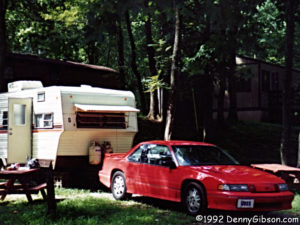 The Storm was fun to drive but was completely inadequate in terms of people hauling. As the 1992 model year came to an end, a bright red Chevrolet Lumina Z34 sitting unsold at the dealer where I’d bought the Geo caught my eye. Enough time had passed since the divorce to let my credit recover to the point I could buy it even though I still owed on the Storm and wasn’t trading it in. It became a graduation gift to my oldest son and he drove it to his new home in San Francisco.
The Storm was fun to drive but was completely inadequate in terms of people hauling. As the 1992 model year came to an end, a bright red Chevrolet Lumina Z34 sitting unsold at the dealer where I’d bought the Geo caught my eye. Enough time had passed since the divorce to let my credit recover to the point I could buy it even though I still owed on the Storm and wasn’t trading it in. It became a graduation gift to my oldest son and he drove it to his new home in San Francisco.
I suspect there were several reasons why the Z34 was hanging around. One may have been price. The typical Lumina was a mid-sized reasonably-priced family-friendly car. The Z34 model not so much. As the performance model it carried a premium and having just two doors somewhat reduced its utility. The bright color and the manual transmission may have also eliminated a few perspective owners. While those things may have made it less desirable to some, they were — except for the price — the very things that attracted me. In the end, the need to “make room for the ’93s” made even the price kind of attractive.
The Chevy was an almost ideal vehicle for me at that time. It held four adults in tolerable comfort which made chauffeuring my daughter and a friend or two absolutely painless. I could even do the lunchtime driving for small groups of coworkers and that was something that had simply not been possible with the Storm. Plus it was fun.
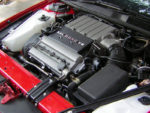 I’ve always liked shifting my own gears. That’s something I’d been reminded of with the Mazda as well as the Storm so the 5-speed manual was a big plus for me. The front wheel drive Storm didn’t handle quite as well as the rear drive Mazda but it was pretty good. The FWD Lumina was bigger than either of those so did not handle as well as either but it was a long way from bad. Plus it could go — and stop — quite well indeed. The 34 in the model designation came from its 3.4 liter V6 engine. With two overhead camshafts on each cylinder bank, this was a pretty exotic engine for General Motors. To this day, it remains the only car I’ve owned with just as many cams as wheels. Output was 210 HP. Four-wheel ABS discs did the stopping. I’ve since owned other cars with this brake setup but the Z34 was my first. I was impressed.
I’ve always liked shifting my own gears. That’s something I’d been reminded of with the Mazda as well as the Storm so the 5-speed manual was a big plus for me. The front wheel drive Storm didn’t handle quite as well as the rear drive Mazda but it was pretty good. The FWD Lumina was bigger than either of those so did not handle as well as either but it was a long way from bad. Plus it could go — and stop — quite well indeed. The 34 in the model designation came from its 3.4 liter V6 engine. With two overhead camshafts on each cylinder bank, this was a pretty exotic engine for General Motors. To this day, it remains the only car I’ve owned with just as many cams as wheels. Output was 210 HP. Four-wheel ABS discs did the stopping. I’ve since owned other cars with this brake setup but the Z34 was my first. I was impressed.
The picture at the top was taken after I’d had the car just a couple of days. I did not tow the camper there. It was one of several rental units in a Kentucky campground bordering the Ohio River. I took my daughter and one of her friends camping there almost as soon as I picked up the car. The trip included a visit to the Kentucky Horse Park where the girls enjoyed some gentle horseback riding. I quit smoking.
It wasn’t exactly planned, but I had finally reached the point where I was mentally ready to quit. What tipped the scale was that smoking had just become too much of a hassle and the acquisition of a new not-yet-smoked-in car seemed a good occasion to go for it. I took no cigarettes on the trip but did take a pack of Between the Acts cigarette style cigars to use in dealing with major nicotine cravings. I essentially finished the first few I smoked but it wasn’t long before a couple of puffs would make me light-headed. I resorted to the little cigars a couple of time after we got home but I never finished the pack and I never smoked in the Lumina.
I did go racing in it though. Once. Kinda. This was the first car I went autocrossing in. Autocrossing (a.k.a. gymkhana) is a race against the clock on a course marked by orange cones. Some friends were into it and I decided to give it a try. A common arrangement is for half of the entrants to line the course as corner workers while the other half raced and then switch roles. I had never even seen an autocross but figured I’d get to watch for awhile before launch time. Nope. Not only was I in the first drivers (rather than workers) group, my slot was so early that I was in line and unable to see much of anything when the few cars in front of me made their runs. To no one’s surprise, I didn’t do well. It wasn’t horrible but it sure wasn’t competitive. I did a little better on subsequent runs but not much. The FWD Lumina was not a particularly good autocross car and I had no idea what I was doing. I would be back, however — in a different car.
My Previous Wheels: Chapter 29 — 1991 Geo Storm
My Next Wheels: Chapter 31 — 1994 Chevrolet Camaro
Book Review
Not For Morbidity’s Sake
Malcolm P. Fletcher
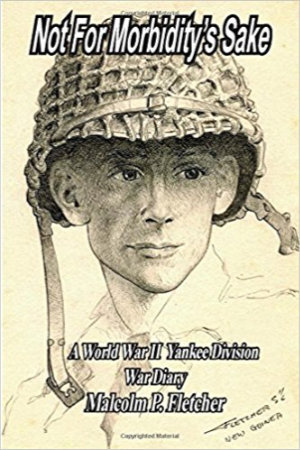 It’s a familiar story I’d never heard before. In no way is use of the word “familiar” meant to be dismissive. It’s just my way of acknowledging that many aspects of Malcolm Fletcher’s story are to be found in the stories of thousands of other World War II soldiers. Of course each of those stories is also unique in ways both small and large. Large happenings that make Fletcher’s story unique include the actions that earned him a bronze star and the day he watched his brother get shot and captured. Getting coffee and doughnuts from the Red Cross in February and washing clothes and shaving in May are among of the not-so-large pieces of the story that make it real. Numerous photographs, maps, and drawings — many by Fletcher himself — really fill things out.
It’s a familiar story I’d never heard before. In no way is use of the word “familiar” meant to be dismissive. It’s just my way of acknowledging that many aspects of Malcolm Fletcher’s story are to be found in the stories of thousands of other World War II soldiers. Of course each of those stories is also unique in ways both small and large. Large happenings that make Fletcher’s story unique include the actions that earned him a bronze star and the day he watched his brother get shot and captured. Getting coffee and doughnuts from the Red Cross in February and washing clothes and shaving in May are among of the not-so-large pieces of the story that make it real. Numerous photographs, maps, and drawings — many by Fletcher himself — really fill things out.
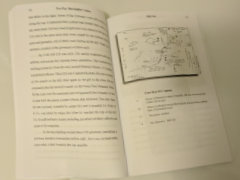 It’s a great story and well told but there’s no denying that the mere fact that it is being shared plays a big role in setting this story apart from most of those others. The majority of those soldiers never told their story to anyone. A relative few did write it down or record it but not many saw an audience beyond family, friends, or a veterans organization. That Malcolm Fletcher wanted to share his story is obvious. He expanded his wartime notes and produced a “diary”. The title is his. Not For Morbidity’s Sake came from the fact that, as his son Michael says in the foreword, “…he took no pleasure in telling most of this story”. Malcolm Fletcher died in 1994 and Michael, with help from his brother Mark, made publication of the diary a reality. To a large degree, this meant editing their father’s writings but they also augmented the story with information gathered from other family members, friends, and even some of the men who served with Malcolm.
It’s a great story and well told but there’s no denying that the mere fact that it is being shared plays a big role in setting this story apart from most of those others. The majority of those soldiers never told their story to anyone. A relative few did write it down or record it but not many saw an audience beyond family, friends, or a veterans organization. That Malcolm Fletcher wanted to share his story is obvious. He expanded his wartime notes and produced a “diary”. The title is his. Not For Morbidity’s Sake came from the fact that, as his son Michael says in the foreword, “…he took no pleasure in telling most of this story”. Malcolm Fletcher died in 1994 and Michael, with help from his brother Mark, made publication of the diary a reality. To a large degree, this meant editing their father’s writings but they also augmented the story with information gathered from other family members, friends, and even some of the men who served with Malcolm.
As mentioned, not many World War II veterans made any attempt to share their stories. In addition, not all who did were particularly good at it. Malcolm Fletcher was. At twenty-four, he was a little older than most of the enlistees he headed to Europe with in 1944. Maybe that made him a little more observant or maybe that just came natural. Either way, his observations fed some rather good sketches and some articulate writing.
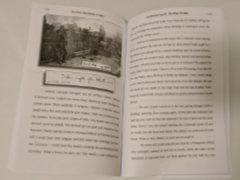 Those observations also fed some slightly philosophical thinking on the horrors of war and the brotherhood of man. He had personal experience with both. Whether the deeper of Fletcher’s thoughts came during his time in Europe or while he subsequently transcribed his notes in safety in the USA is unclear and unimportant. He was in the midst of battles where men destroyed each other with cannons, bombs, rifles, bayonets, and flame-throwers. He saw many and met a few French, Belgium, and German civilians whose world was ravaged beyond comprehension. And he was there at the end of the conflict interacting with German and Russian soldiers to learn that “These Russies are just like us.”
Those observations also fed some slightly philosophical thinking on the horrors of war and the brotherhood of man. He had personal experience with both. Whether the deeper of Fletcher’s thoughts came during his time in Europe or while he subsequently transcribed his notes in safety in the USA is unclear and unimportant. He was in the midst of battles where men destroyed each other with cannons, bombs, rifles, bayonets, and flame-throwers. He saw many and met a few French, Belgium, and German civilians whose world was ravaged beyond comprehension. And he was there at the end of the conflict interacting with German and Russian soldiers to learn that “These Russies are just like us.”
He was there as a strange calmness came to a devastated Europe and plans were being made to send him and lots of other men to tackle the Japanese. He was there when Hiroshima and Nagasaki were bombed and the war ended without an invasion. He came home to a world that was damaged in its own way. He stumbled. He regained his balance. He wrote his story. The basic plot may be familiar but the details are unique and personal and the telling is something special.
Not For Morbidity’s Sake: A World War II Yankee Division War Diary, Malcolm P. Fletcher, CreateSpace Independent Publishing Platform (December 10, 2017), 6 x 9 inches, 226 pages, ISBN 978-1981114696
Available through Amazon.
I know Michael Fletcher through his work as a bassist with several local bands. I’ll admit that’s it’s rather unlikely I would have found this book on my own otherwise. But, if I had, there is no doubt that I would have enjoyed it. Knowing Mike or even knowing who Mike is is certainly not required to appreciate his father’s story. On the other hand, I probably enjoyed this book more than many and it’s certain that the story is more familiar to me than most. Malcolm Fletcher’s time in the military more or less parallels that of my own father. Both probably crossed the Atlantic in the same convoy although Dad landed in England rather than France. Both were at the Battle of the Bulge and both were early crossers of the Siegfried Line.
But there were definitely big differences. Dad was a courier and spent most of his time driving a Jeep or truck. He was usually at or near the front but was not directly involved in the fighting in the way Malcolm Fletcher was. And he never talked about it the way Malcolm Fletcher did. I kind of wish he had. I’d certainly like to know more but I think his “silence” was rather typical. There were occasional, seemingly spontaneous, reminisces that provided cherished glimpses but no long stories and no writing or recording.
Dad served with the 78th “Lightning” Division. Until about four years ago, there was an associated veterans group that published a quarterly newsletter called The Flash. Veteran’s memories were an important part of its makeup and I read many of them. There are, naturally, similarities between the stories of every soldier in every war in every location but I was thinking specifically of the stories I’d read in The Flash when I called Not For Morbidity’s Sake “..a familiar story I’d never heard before.” I wrote about the newsletter’s end in One Last Flash in 2013.
My Wheels — Chapter 27
1985 Mazda RX7
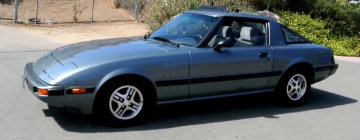 Details of timing are lacking for both this and the following My Wheels chapter. I think I’ve got the sequence right but I’m not even entirely certain of that. The two are connected by more than a lack of precision in dates but I don’t expect this chapter to explain things very well. Hopefully I’ll be able to make things clearer in the next chapter when all the pieces have been identified.
Details of timing are lacking for both this and the following My Wheels chapter. I think I’ve got the sequence right but I’m not even entirely certain of that. The two are connected by more than a lack of precision in dates but I don’t expect this chapter to explain things very well. Hopefully I’ll be able to make things clearer in the next chapter when all the pieces have been identified.
The subject of this chapter was my oldest son’s car. I cosigned the loan and he made all the payments on time and handled all other expenses, including insurance, right up until he needed it. At some point the financial load became a bit too much and he decided to sell it. No need to insure a car you’re going to sell. Right? As often happens, the decision to sell and the decision to drop insurance preceded the decision to stop driving and, pretty much on cue, there was an accident. It wasn’t a huge one and it was a single vehicle thing but it left him with something that could neither be driven or easily sold. What happened next was pretty much on cue, too. Dad the cosigner became sole owner of the undrivable, unsalable, uninsured, and unpaid for Mazda. That’s not the actual car in the photo but it’s a perfect match except for the sunroof.
I got the damage repaired and the car insured and I drove it for awhile. It was a rather a fun car to drive. The rotary engine seemed like it would accelerate — at least a little — forever. It was, however, a toy I really couldn’t afford at the time. As I said at the beginning, details of timing are lacking and some of the related details involve my second marriage and divorce. I know I had the car both before and after the short lived marriage but I’m understandably just not capable of fitting all the pieces together.
Either during or shortly after the marriage, my younger son bought the car. I’m fairly certain he did it for my benefit. He was in the Navy with no expenses. He also had no driver’s license. He hadn’t felt the need in high school and had entered the Navy on graduation. Plans were made for him to get his license then see a bunch of the country driving the Mazda to his assignment in San Diego. There was only time for one shot at a license and it was a miss. As I recall, the big dig was activating turn signals way too early but I’m guessing that a general nervousness contributed a lot. He flew to San Diego and the Mazda was parked in the garage to await his return.
Although he did eventually get his license (The Navy needed him to drive something.) he never took possession of the car. After a year or so he/I sold the car to a friend. I had let it sit idle for too long and it took some effort to get it running again. It became a daily driver for its new owner until a winter ice attack in traffic brought about its demise.
My Previous Wheels: Chapter 26 — 1986 Acura Legend
My Next Wheels: Chapter 28 — 1978? Yamaha 400
